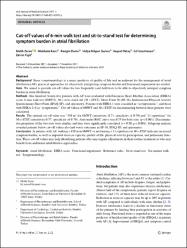Cut-Off Values of 6-min Walk Test and Sit-to-Stand Test for Determining Symptom Burden in Atrial Fibrillation

View/
Access
info:eu-repo/semantics/openAccessDate
2022Author
Zeren, MelihKarcı, Makbule
Demir, Rengin
Gürses, Hülya Nilgün
Oktay, Veysel
Uzunhasan, Işıl
Yiğit, Zerrin
Metadata
Show full item recordCitation
Zeren, M., Karci, M., Demir, R. et al. Cut-off values of 6-min walk test and sit-to-stand test for determining symptom burden in atrial fibrillation. Ir J Med Sci (2022). https://doi.org/10.1007/s11845-021-02901-Abstract
Background Since symptomatology is a major predictor of quality of life and an endpoint for the management of atrial fibrillation (AF), practical approaches for objectively interpreting symptom burden and functional impairment are needed. Aims We aimed to provide cut-off values for two frequently used field tests to be able to objectively interpret symptom burden in atrial fibrillation. Methods One hundred twenty-five patients with AF were evaluated with European Heart Rhythm Association (EHRA) score, 6-min walk test (6MWT), 30 s sit-to-stand test (30 s-STST), Short-Form 36 (SF-36), International Physical Activity Questionnaire-Short Form (IPAQ-SF), and spirometry. Patients with EHRA 1 were classified as "asymptomatic", and those with EHRA 2-4 as "symptomatic". Cut-off values of 6MWT and 30 s-STST for discriminating between these patients were calculated. Results The optimal cut-off value was "450 m" for 6MWT (sensitivity: 0.71; specificity of 0.79) and "11 repetitions" for 30 s-STST (sensitivity 0.77; specificity of 0.70). Area under ROC curve was 0.75 for both tests (p < 0.001). Discriminative properties of the two tests were similar, and they were significantly correlated (r = 0.58; p < 0.001). Subgroup analysis revealed patients below cut-off values also had worse outcomes in SF-36, IPAQ-SF, and spirometry. Conclusions In patients with AF, walking < 450 m in 6MWT or performing < 11 repetitions in 30 s-STST indicates increased symptom burden, as well as impaired exercise capacity, quality of life, physical activity participation, and pulmonary function. These cut-off values may help identifying patients who may require adjustments in their routine treatment or who may benefit from additional rehabilitative approaches.

















